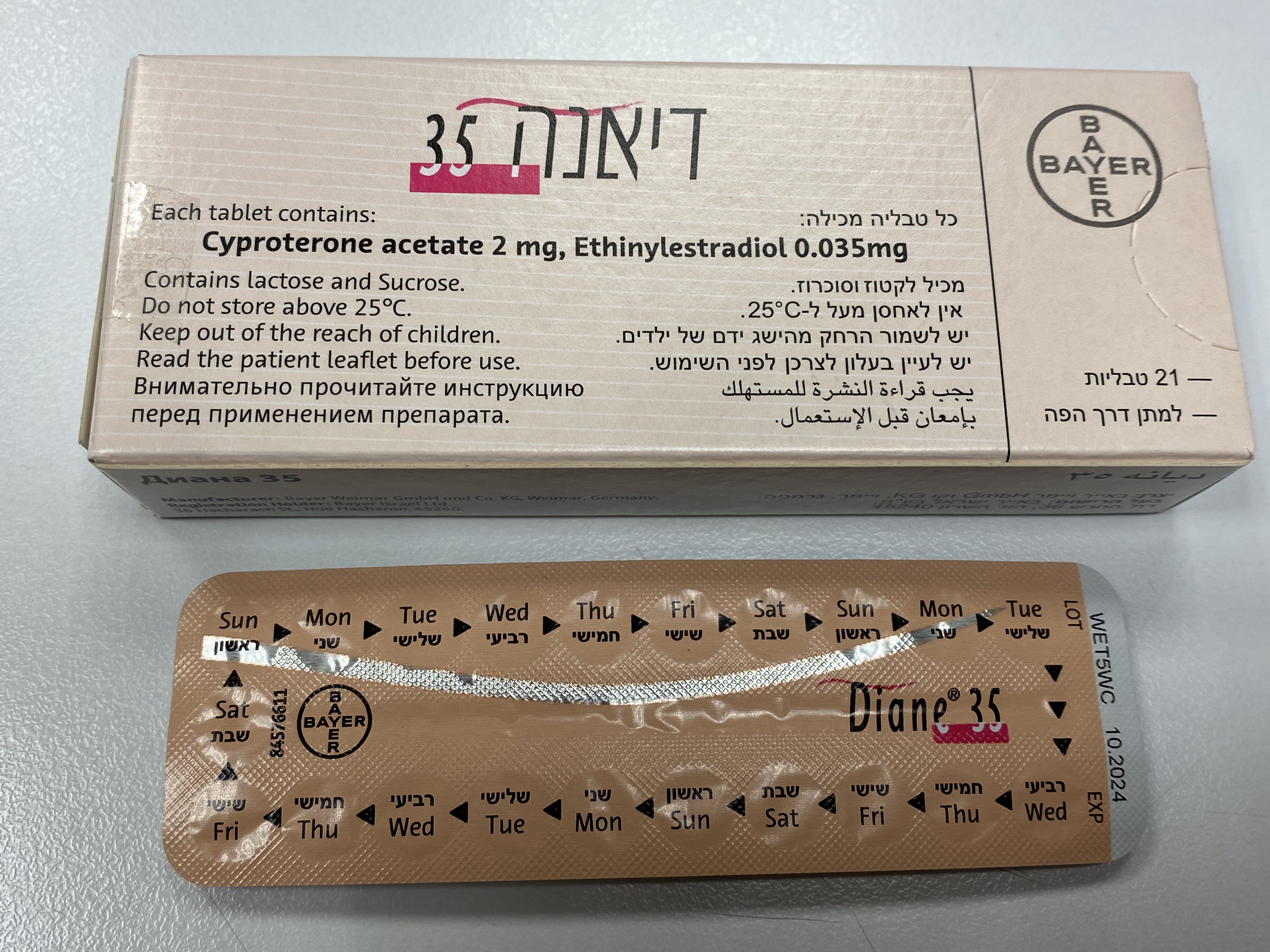Quest for the right Drug

דיאנה 35 DIANE ® 35 (CYPROTERONE ACETATE, ETHINYLESTRADIOL)
תרופה במרשם
תרופה בסל
נרקוטיקה
ציטוטוקסיקה
צורת מתן:
פומי : PER OS
צורת מינון:
טבליה : TABLETS
עלון לרופא
מינוניםPosology התוויות
Indications תופעות לוואי
Adverse reactions התוויות נגד
Contraindications אינטראקציות
Interactions מינון יתר
Overdose הריון/הנקה
Pregnancy & Lactation אוכלוסיות מיוחדות
Special populations תכונות פרמקולוגיות
Pharmacological properties מידע רוקחי
Pharmaceutical particulars אזהרת שימוש
Special Warning עלון לרופא
Physicians Leaflet
Adverse reactions : תופעות לוואי
4.8 Undesirable effects Summary of safety profile The most commonly reported adverse reactions with Diane 35 are nausea, abdominal pain, increased weight, headache, depressed mood, altered mood, breast pain, breast tenderness. They occur in ≥ 1 % of users. There is an increased risk of thromboembolism for all women who use Diane 35 (see section 4.4). Tabulated list of adverse events System Organ Adverse events reported in clinical trials Adverse events Class reported post Common Uncommon Rare marketing (≥ 1/100 (≥ 1/1000 to (≥1/10,000 to to <1/10) <1/100) < 1/1000) Eye disorders contact lens intolerance Gastrointestinal nausea, vomiting, disorders abdominal pain diarrhea Immune system hypersensitivity exacerbation of disorders hereditary angioedema Investigations weight weight decreased increased Metabolism and fluid retention hypertriglyceridemia nutrition disorders Nervous system headache migraine exacerbation of disorders chorea Gastrointestinal Crohn's disease, disorders ulcerative colitis Hepatobiliary liver function disorders disturbances Psychiatric depressed libido decreased libido increased disorders mood, mood altered Reproductive breast pain, breast vaginal discharge, reduced menstrual system and breast breast hypertrophy breast discharge flow, spotting, disorders tenderness breakthrough bleeding and missed withdrawal bleeding, post pill amenorrhoea Skin and rash, urticaria erythema nodosum, chloasma subcutaneous erythema multiforme tissue disorders Vascular Thromboembolism increase in blood Disorders pressure Description of selected adverse reactions Post-marketing reports of severe depression (including very rare reports of suicidal ideation or behaviour) in patients using Diane 35 have been received. However, a causal relationship between clinical depression and Diane 35 has not been established. An increased risk of arterial and venous thrombotic and thrombo-embolic events, including myocardial infarction, stroke, transient ischemic attacks, venous thrombosis and pulmonary embolism has been observed in women using CHCs, which are discussed in more detail in section 4.4. The following serious adverse events have been reported in women using CHCs, which are discussed in section 4.4 'Special warnings and precautions for use': • Venous thromboembolic disorders; • Arterial thromboembolic disorders; • Hypertension • Liver tumours; • Occurrence or deterioration of conditions for which association with COC use is not conclusive: Crohn’s disease, ulcerative colitis, epilepsy, uterine myoma, porphyria, systemic lupus erythematosus, herpes gestationis, Sydenham's chorea, haemolytic uremic syndrome, cholestatic jaundice; • Chloasma; • Acute or chronic disturbances of liver function may necessitate the discontinuation of COC use until markers of liver function return to normal. • In women with hereditary angioedema exogenous oestrogens may induce or exacerbate symptoms of angioedema. The frequency of diagnosis of breast cancer is very slightly increased among COC users. As breast cancer is rare in women under 40 years of age the excess number is small in relation to the overall risk of breast cancer. Causation with COC use is unknown. For further information, see sections 4.3 and 4.4. Interactions Breakthrough bleeding and/or contraceptive failure may result from interactions of other drugs (enzyme inducers) with oral contraceptives (see section 4.5). Reporting of suspected adverse reactions Reporting suspected adverse reactions after authorisation of the medicinal product is important. It allows continued monitoring of the benefit/risk balance of the medicinal product. Any suspected adverse events should be reported to the Ministry of Health according to the National Regulation by using an online form https://sideeffects.health.gov.il/

שימוש לפי פנקס קופ''ח כללית 1994
Signs of androgenization in women
תאריך הכללה מקורי בסל
01/01/1995
הגבלות
תרופה שאושרה לשימוש כללי בקופ'ח
מידע נוסף
